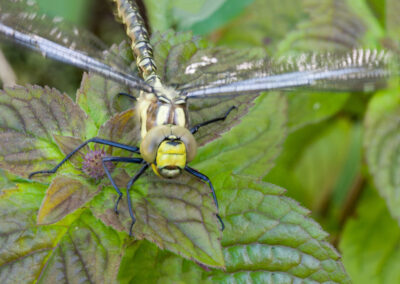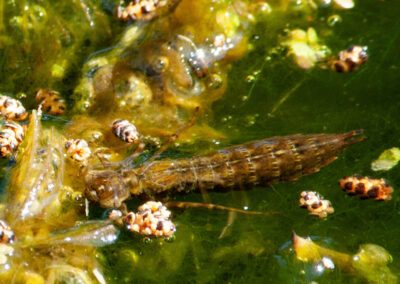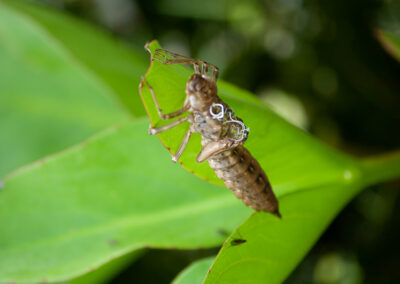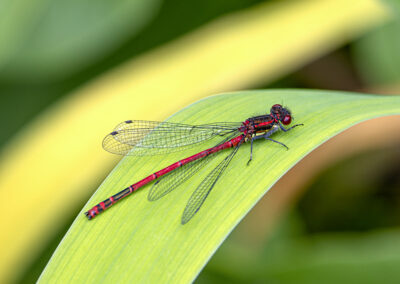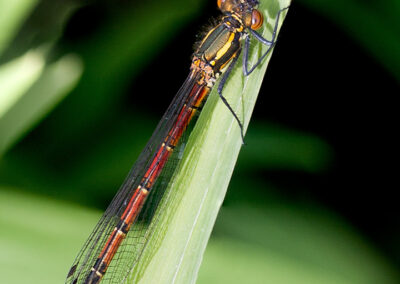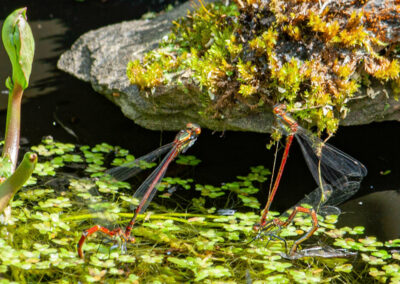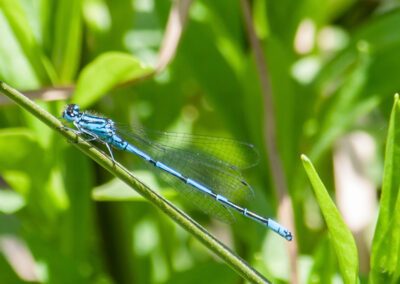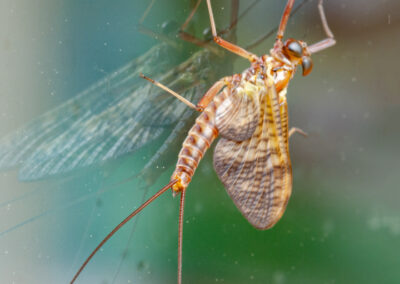Dragonflies, Damselflies & Mayflies
These belong to one of the oldest groups of insects, termed the Palaeoptera, which contains the orders Odonata (Dragonflies and Damselflies) and Ephmeroptera (Mayflies). Their ancestors were some of the first winged insects, with fossils dating back over 300 million years. The main feature of Paleoptera is that they are unable to fold their wings along their abdomen when at rest, instead either holding them vertically above the bodies (Damselflies and Mayflies), or outstretched to the sides (Dragonflies).
There is some disagreement amongst entomologists about the classification of these insects, which is not something for here!
Dragonflies & Damselflies
Dragonflies and damselflies belong to the order Odonata. In the UK there are 36 species of dragonfly and 21 species of damselfly, though in recent years, due to climate change, more species have been visiting from mainland Europe and are likely to establish a breeding presence in the UK.
The main differences between dragonflies and damselflies are:
- Their resting postures – dragonflies rest with their wings straight out, like an aeroplane, whereas damselflies have their wings folded together above their bodies.
- Their wings – both have 2 pairs of wings; both pairs of damselfly wings are the same size and shape, which taper towards where they attach to the body; both pairs of dragonfly wings are of similar size, but the rear pair are broader towards their base where they join the body.
- Although it can sometimes be difficult to notice unless observing them side-by-side; damselflies are smaller than dragonflies, their bodies being about 3.5 – 5cms. long, and quite thin; dragonfly bodies are generally longer than 5 cms. and thicker than those of damselflies.
- A dragonfly’s eyes are very large, taking up most of its head, wrapping around the sides and almost joing at the front; damselflies eyes are also quite large, but noticeably smaller that those of a dragonfly, and there is a much more of a gap between them.
Terminology used in the gallery:
‘teneral’ – the stage after the adult first emerges from its nymph exoskeleton, when its body is still soft and doesn’t exhibit the final colouration of the adult.
‘exuvia’ – the shed larval skin from which the adult has emerged.
Read more about dragonflies and damselflies below their galleries.
Dragonflies
Common Goldenring Dragonfly (Cordulegaster boltonii)
Common Goldenring Dragonfly (Cordulegaster boltonii)
Damselflies
Life-cycle
Dragonflies and damselflies undergo incomplete metamorphosis, having three stages in their life-cycle – egg, nymph / larva, adult.
Eggs – some species lay directly into the water, the eggs being encased in a jelly-like substance. This behaviour is often seen, the adults skimming just above the water surface and repeatedly dipping the rear of their abdomen into the water to lay an egg. Other species lay their eggs into the stems of plants, rotten wood or mud close to the water. Eggs usually hatch within 2 – 5 weeks, though in some species they can over-winter and hatch the following spring.
Nymph / larva – most of these insects’ life-cycle is spent as nymphs, spending from 2 – 3 months to as much as 5 years at this stage, depending on species. They are carnivorous, feeding on tadpoles, small fish, other insect larvae, crustaceans, worms snails and leeches. To grow, they shed their exo-skeleton (outer skin) between 5 and 14 times until fully-grown.
Adults – they live for between 1 and 8 weeks, feeding on other flying insects.
Mating behaviour
Dragonfly mating is unique. Males have two sets of genitalia, one at the tip of the abdomen, as is usual in most insects, but they also have a secondary set at the top of the abdomen just behind the head. Before mating, the male transfers sperm from the genitalia at the tip of its abdomen to the secondary set near its head. During mating, the male grasps the female with the claspers at the tip of his abdomen, and the female curls the tip of her abdomen to meet the male’s secondary genitalia, and transfers the sperm from there to herself. In some species this activity can take a few seconds, but in others it might take a few hours, which is why some species can be seen flying around ‘in tandem’. They may mate several times during their short lives.
Mayflies
Over 3,000 species of Mayfly, in 42 families, are known worldwide, of which 51 species live in the UK.
They have 2 or 3 long tail filaments, and 2 pairs of membranous wings, the front pair being much larger than the rear pair.
They undergo incomplete metamorphosis, having no pupal stage. The nymphs of some species may send up to 2 years living on the river bed, before emerging as adults, which usually live only a few hours – just long enough to mate and for the females to lay eggs.
Mayflies are unique amongst the insects in that there are two different winged adult forms in their life cycle. The nymph emerges from the water as a dull-coloured ‘dun’ (sub-imago) that seeks shelter in bankside vegetation. After a couple of hours, the dun sheds its skin to transform into the more brightly-coloured adult (imago). They are notorious for often having a massive simultaneous emergence of often many thousands of individuals.
The nymphs are herbivores, feeding on algae and plant detritus. The adults do not feed. Mayfly nymphs, and the adults emerging from the water, are an important source of food for many other freshwater animals, especially fish such as trout and salmon.


